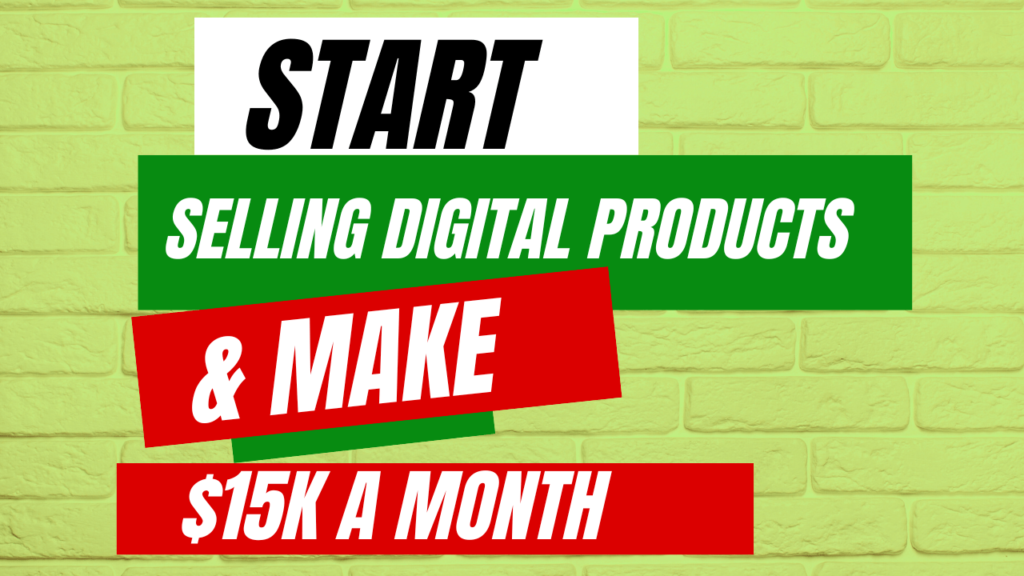Selling digital products, offers unprecedented opportunities for entrepreneurs and creatives alike. If you’ve been dreaming of making a steady income online, selling digital products can be a highly lucrative venture. But where do you start, especially if you’re a complete beginner? This guide will take you through the steps you need to follow to start selling digital products and potentially make $15,000 a month.
Why? Selling Digital Products?
Before we get into the how, let’s talk about the why. Selling digital products has several advantages:
Low Overhead Costs: Unlike physical products, digital products don’t require inventory, storage, or shipping.
Scalability: Once created, digital products can be sold an infinite number of times without additional production costs.
Flexibility: You can create products that align with your interests and expertise, allowing you to enjoy what you do.
Step 1: Identify Your Niche
The first step to selling digital products is identifying a profitable niche. Here are some tips to help you find your niche:
- Research Market Demand: Use tools like Google Trends, Keyword Planner, and social media platforms to gauge interest in different topics.
- Identify Your Passion and Expertise: Choose a niche that you are passionate about and have some level of expertise in. This will make it easier to create high-quality content.
- Analyze Competitors: Look at what other successful sellers in your niche are offering. Identify gaps in the market that you can fill.

Step 2: Choose the Right Digital Products
Once you’ve identified your niche, it’s time to decide what types of digital products to sell. Here are some popular options:
- Ebooks: Share your knowledge and expertise in a written format.
- Online Courses: Create comprehensive guides or tutorials on a specific topic.
- Printables: Design templates, planners, and other printable materials that users can download and use.
- Software and Apps: Develop tools that solve specific problems or make tasks easier.
- Stock Photos and Graphics: If you’re a photographer or designer, sell your work as digital downloads.

Step 3: Create High-Quality Content
Creating high-quality digital products is crucial for success. Here are some tips to ensure your products stand out:
- Focus on Value: Ensure your product provides real value and solves a problem for your audience.
- Invest in Quality: Use professional tools and software to create your products. For example, use Adobe Creative Suite for design or Camtasia for video editing.
- Test and Refine: Before launching, test your product with a small group of users and use their feedback to make improvements.

Step 4: Set Up Your Sales Platform
To start selling your digital products, you’ll need a platform to host and sell them. Here are some popular options:
- Shopify: A versatile e-commerce platform that allows you to sell digital products.
- Etsy: Ideal for printables, artwork, and craft-related digital products.
- Teachable and Udemy: Great for hosting and selling online courses.
- Gumroad and Sellfy: Simple platforms for selling a variety of digital products.

Step 5: Promote Your Products
Promotion is key to driving sales. Here are some effective strategies:
- Content Marketing: Start a blog or YouTube channel related to your niche and use it to promote your products.
- Social Media: Use platforms like Instagram, Facebook, and Pinterest to reach your target audience.
- Email Marketing: Build an email list and send regular newsletters to keep your audience engaged.
- Paid Advertising: Invest in targeted ads on Google, Facebook, or Instagram to reach a broader audience.

Step 6: Monitor and Optimize
Once your products are live, it’s essential to monitor their performance and make adjustments as needed:
- Analytics: Use tools like Google Analytics to track traffic and sales
- Customer Feedback: Encourage reviews and testimonials to understand what your customers love and what needs improvement.
- A/B Testing: Experiment with different pricing, copy, and promotional strategies to see what works best.

Conclusion
Starting a digital product business can be a highly rewarding venture, both financially and personally. By following these steps and committing to continuous learning and improvement, you can build a successful business that generates $15,000 a month or more. Ready to get started? Begin by identifying your niche and creating your first digital product today
carefully researched
Strategies worked for me
benefited a lot of useful tips. I have applied them. They works
nice post



Your work has captivated me just as much as it has you. The sketch you’ve created is tasteful, and the material you’ve written is impressive. However, you seem anxious about the prospect of presenting something that could be considered questionable. I believe you’ll be able to rectify this situation in a timely manner.